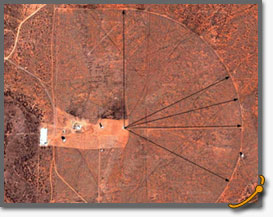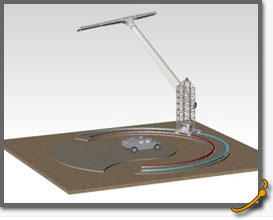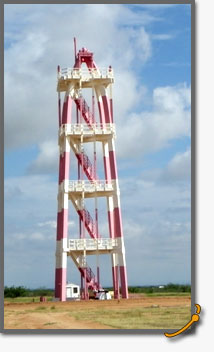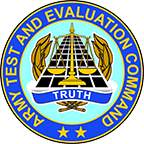- Homepage >
- Facilities >
- Antenna Test Facility
Antenna Test Facility
Overview

The Antenna Test Facility (ATF) measures the electrical performance of antennas systems mounted on or off ground and air vehicles for commercial or military use.
The ATF provides a modern antenna test facility capability of handling the majority of antenna systems on ground vehicles and air vehicles in the U.S. Military’s inventory.
Sprawling over 400 acres, the ATF is composed of 7 main facilities and numerous sub facilities:
- Two Outdoor Arc Ranges (75 and 50 feet radius for far field or near field test capability)
- An Outdoor 100 foot Low Observable Tower configurable with two 500 foot far field positions system
- Two outdoor positioners with large load capabilities (60 and 80 ton)Turntables
- Compact Range (Outdoor) with a high load (40 Tons) capacity
- Near Field Range (Indoor), configurable as a planar, cylindrical and spherical coordinates
- Outdoor beacon locator range
Facilities
The operational facilities are:
-
Arc Range:
- Laminated wood
- 75’ Arc radius
- 60’ diameter, 80 ton capacity turntable centered at its base that rotates 360° azimuth (the angle between a reference plane and a point) to provide a polar or rectangular antenna pattern
- Hemispherical measurements can be taken from -40° to 90° in elevation and 360° in azimuth
- Supports theta and phi coordinates for spherical near field measurements
- Fiberglass with a wooden deck test pedestal can hold test vehicle up to 40 tons, 25' off the positioner
- Supports antenna testing from 20 megahertz (MHz) up to 18 gigahertz (GHz)
-
Low Observable Tower Range:
- 100’ wooden tower located 500’ from the Arc turntable
- 30’, 60 ton capacity turntable is located another 500’ east of the Arc
- Antenna sleds on two sides of the tower are used as a source tower for either elevated or reflections range measurements between the Arc azimuth and the east table positioner (allow elevation angles of a test or source antennas between ground level and 100')
-
Configurable Range
- Situational Awareness/Direction Finding - Provide Radio Frequency (RF) testing capabilities for conducting specialized test of direction finding, emitter identification, and other RF signal processing systems
- The 30’ diameter table is the focal point of a ½ mile arc with geodetic survey points every 5 degrees.
-
Small Arc

- New design concept with scan axis on a circular track instead of the vehicle rotating on a turntable. Advantages include unlimited weight of the test vehicle and geothermal properties of the Arizona desert maintaining constant rail and foundation temperature.
- A 50' radius gantry arm is attached to rails on a tower, which is supported by the cart that travels around the circular track.
- The height of the gantry arm radius is adjustable from 0 (reference) to over 16.4 ft in order to accommodate vehicles of different heights as well as allowing for angles below horizon when the vehicle is elevated.
- The circular track allows for over 200 degrees of travel and the gantry arm will rotate over 200 degrees for complete coverage of a 50' radius hemisphere with adjustable center height.
- Using an 80 ton lifting system, negative angles up to 15 degrees below horizon will be possible. The lifting system will also allow for up to +/- 20 degrees of pitch and roll.
-
Compact Range
- will support precise far-field measurements at higher microwave frequencies
- Frequency range of 6 to 60 GHz
- Vehicles and antennas weighing up to 40 tons and up to 50 feet in diameter
- The positioner configuration is capable of raising test items from 0° to 90° in elevation while rotating it 360° in azimuth
Types of Tests
The ATF has the ability to conduct five main types of tests:
-
Antenna radiation patterns
- Beam width
- Side lobe
- Null depth
- Electrical bore sight
- Mechanical bore sight
-
Antenna radiation pattern subsets
- Relative antenna gain (dB)
- Absolute antenna gain (dBi)
- Directivity
- Efficiency
- Standing Wave Ratio (SWR)
- Frequency Bandwidth
- Special Tests
Types of Antennas

Three types of antennas are used for testing at the ATF:
- Directional
- Omni-directional
- Active arrays
Various Programs Supported
- MRAP
- CREW
- STRYKER
- WIN-T
- SINCGARS
- Zumwalt
- EPLRS
- GPS
- Prophet
- JTRS
- JLTV
- AMPV
-
COSPAS-SARSAT
- Russian for “Space System for the Detection of Vessels in Distress” - Search and Rescue Satellite Aided Tracking
-
COSPAS-SARSAT provides global air, sea and land search and rescue coverage using
two satellite systems:
- Medium-altitude Earth Orbit System for Search and Rescue (MEOSAR)
- Low Earth Orbit System for Search and Rescue (LEOSAR)
- Geostationary Search and Rescue (GEOSAR)
-
More than 430,000, 406 MHz Emergency Beacons are currently registered with COSPAS-SARSAT;
covering:
- Air (ELT – Emergency Locator Transmitter)
- Land (PLB – Personal Locator Beacon)
- Sea (EPIRB – Emergency Position Indicating Radio Beacon)


